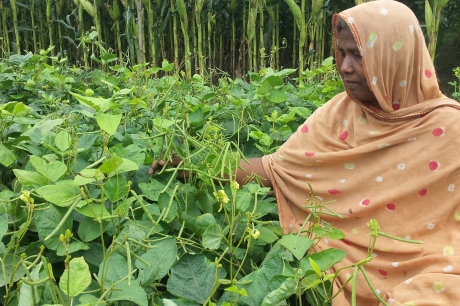Pulses have the potential to improve everything from soil health to healthy diets. They are the dried edible seeds of legumes both cultivated for food and feed. If you didn’t know already, they have the potential to transform our agrifood systems.
Colourful and flavourful, small yet powerful, pulses include the well-known beans, lentils, chickpeas and peas but there are also the lesser-known kinds like tarwi beans and adzuki beans.
Pulses do not only boost our food security and nutrition, but they also nourish our soils and benefit the environment.
This 10 February, World Pulses Day, the Food and Agriculture of the United Nations (FAO) is highlighting the potential that these small and powerful seeds have to improve everything from soil health to healthy diets.
Here are four ways in which pulses nourish soils and soils nourish us:
1. Pulses make essential nutrients available to soils
It is widely known that healthy soils contribute to growing healthy and nutritious foods. But did you know that pulses also improve soil health by providing and mobilising nutrients such as nitrogen, phosphorous and micronutrients?
Pulses get over 60 per cent of their nitrogen from the air. This nitrogen is then fed into the soil and allows these legumes to share this nitrogen with nearby crops, essentially reducing the need for chemical fertilisers. This unique ability is called biological nitrogen fixation – where they convert atmospheric nitrogen gas into ammonia (a plant-useable form of nitrogen).

Phosphorous is another much-needed but often lacking nutrient in soils, crucial for converting the sun’s energy and helping plants grow. However, phosphorous is often only present in small amounts and even then, may be in chemically unavailable forms. As a result, farmers add mineral fertilisers to offset this loss.
Pulses have a natural capacity to mobilise phosphorous and other essential nutrients and micronutrients to soils which can contribute to healthier and larger crop yields. With this in mind, FAO and its Global Soil Partnership promote planting pulses in rotation with staple crops to enrich the soils and help yield more nutritious food. For example, in Bangladesh, FAO promoted crop rotation of mung beans with rice crops. This project aims to combat “hidden hunger” – a micronutrient deficiency that occurs despite consuming daily adequate calories. This condition is prevalent in the populations of many countries.
2. They help maintain soil biodiversity
Soils are home to 50 per cent of our planet’s biodiversity. Typically, healthy soils contain earthworms, nematodes, 20-30 species of mites, 50-100 species of insects, hundreds of species of fungi and thousands of species of bacteria and actinomycetes. This is soil biodiversity: diverse living organisms interacting with one another and performing essential services such as nutrient cycling, soil carbon sequestration and greenhouse gas emission.
A healthy soil biodiversity leads to not only greater resistance to and resilience against disturbances and stress but also enhances the ability of the ecosystem to suppress diseases. This is where pulses come in. Pulses help to increase the amount and diversity of microfauna in soil. With more microbes, there is more nutrient recycling and soil organic matter regulation – thus, improving soil biodiversity.

Instead of misusing or overusing agro-chemicals which can result in environmental degradation, pulses used in crop rotation systems help to curb and control pests and diseases.
3. Pulses enhance soil structure
Soil structure is the way in which individual sand, silt and clay particles are assembled. If the soil is crumbly and porous with well-distributed roots, there is good soil structure. However, if the soil is compact (tough to pull apart), the soil structure may be poor.
Producing legumes, such as pulses, improves soil structure. It has long-term benefits, one of which is increasing pore space and cohesion in soils, thereby improving water-holding capacity and soil aeration. In addition, due to the deep root system and longer growth period of pulses, soil structure effectively improves.
4. Pulses help to mitigate and adapt to climate change
Pulses with their ability to mobilise essential nutrients to soils can help reduce the need for chemical fertilisers and help to decrease greenhouse gas emissions – major drivers of climate change. They also increase root development, boosting carbon sequestration and contributing to climate change mitigation.
In addition, because of pulses’ broad range of genetic diversity, certain varieties that are more climate-resilient can be selected or bred. Especially with heat stress affecting crops, these pulse varieties can help farmers where water is less available.
By intercropping at least one pulse variety with a cereal-based crop, agricultural fields are better adapted to climate adversities like drought. This model has already proven to be a success in Tanzania where cereals (maize, sorghum), legumes (beans) and nuts (groundnuts) are grown simultaneously.
Pulses and soils as a dynamic duo play a fundamental role in providing nutritious food, enhancing agrobiodiversity, mitigating climate change and boosting livelihoods.
They provide soils with essential nutrients; then soils provide food with essential nutrients for us, contributing to healthier diets overall.
This piece was initially published on FAO and has been revised to suit Farming First’s editorial guidelines.



